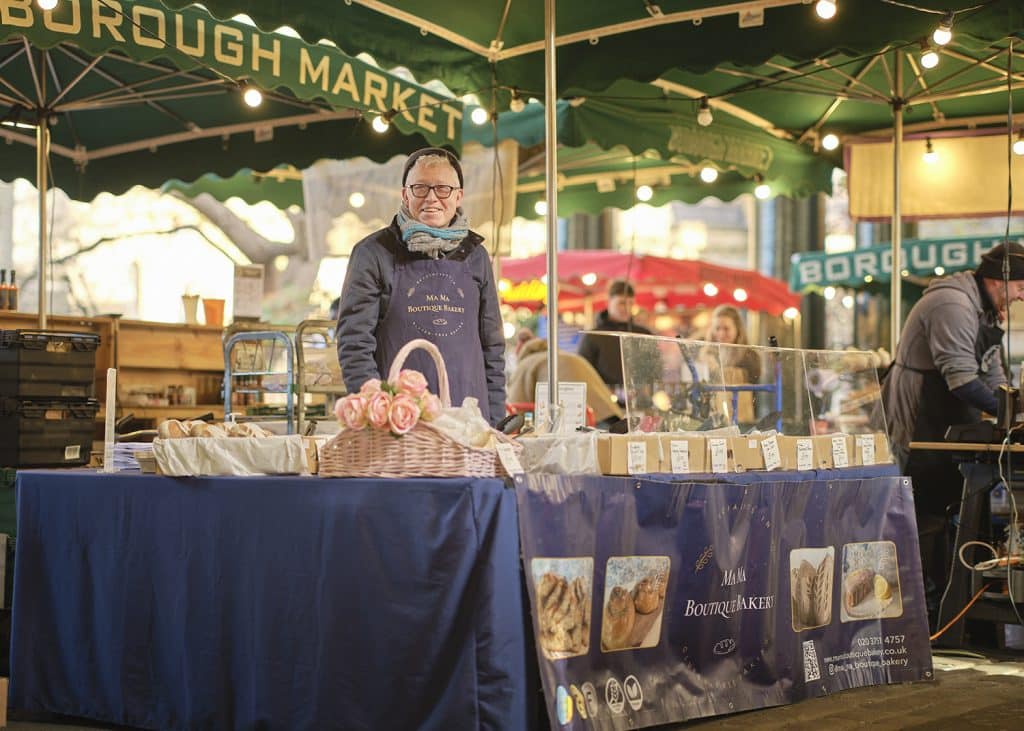Loaf story
How the fates lined up to lead Marzena and Nigel of Ma Ma Boutique Bakery to their gluten-free bakery stall at Borough Market


“I NEED TO KEEP THE FOOD HEALTHY; JUST A FEW NATURAL INGREDIENTS, NOT 1,000 INGREDIENTS IN A BOWL”
Words: Mark Riddaway
It turns out, if you wind it all the way back, that the story of Ma Ma Boutique Bakery, the most recent addition to Borough’s trader community, began right here at the market.
“I’m Polish, so all my life my grandpa, my dad and now me have made a hare pâté for Christmas,” explains Marzena Lubaszka, one of the bakery’s co-founders. After Marzena laid down roots in London, this required a very specific shopping trip: “Here, to get a hare you had to travel to Borough Market.” Every December, she would pay a visit to the Furness Fish Markets stand to collect hare and venison. One year, she happened to catch the eye of a fellow visitor to the market.
“Marzena was shopping and I was having a few beers in the courtyard of the Wheatsheaf pub with some German friends,” says Nigel Ryan, her husband and business partner. “I asked for her number, but she wouldn’t give it to me. After a little bit of cheek from me, she agreed to take mine. It all started there.”
Their marriage came first, their bakery came later, and its creation was a response to a less cheerful confluence of fates than their initial crossing of paths. “Nigel had bowel cancer,” says Marzena. “After the surgery, his surgeon suggested a gluten-free diet.” Around the same time, Marzena was advised by her endocrinologist to cut out gluten in the hope of relieving a thyroid problem.

Marzena, a trained chef and dietician who grew up in a family steeped in food (her grandfather was a professional baker, her parents mushroom farmers), wasn’t prepared to let the sudden removal of gluten from the household undermine the quality of her domestic output. “I’ve always been baking, always making everything from scratch, always having people over for dinner parties,” she says. “That was me, always with food.” To her, the next step was obvious: teach herself to be the best-possible gluten-free baker.
The problem is, becoming a really good gluten-free baker is much easier said than done. Gluten is a truly magical substance: an elastic, net-like structure formed when the proteins in wheat flour come into contact with water. Many of the qualities we value most highly in breads, cakes and pastries – lightness, airiness, chewiness – develop from gluten’s unique binding properties and its ability to sequester air within its robust but stretchy strands. Take that wizardry away and you risk being left with something more brick than bread.
A cursory examination of supermarket products made clear to Marzena that the solution favoured by large-scale food manufacturers is to throw industrial chemistry at the problem: starches, humectants, stabilisers, gums. “I looked at the ingredients and there were things I couldn’t understand,” she says. “I couldn’t even pronounce some of the names. So much different stuff. But I started gluten-free baking because of health reasons, so I need to keep the food healthy; just a few ingredients, whatever is natural, not 1,000 ingredients in a bowl.”
Marzena set out on a mission to match the purity of a regular sourdough loaf: flour, water, salt and the magical microbes of a sourdough starter. “I’m very passionate about my breads; every day I work on their crumb, to be less dense. It’s very difficult to achieve, but I have a very strong work ethic.” It is, she suggests, a craft, not a science. “Dough is alive. I’ve been doing this for a long time, so just by touching the dough I know exactly whether it is good or not. Everything needs a personal touch.” She applies the same care to pastries, cakes and desserts: simple, unadulterated, packed with flavour, but absent the gluten.
What began as a personal quest became a business after Nigel’s health challenges required him to step back from his City job. “We had some savings, and we came up with this idea – to help people like us, to help coeliac people, to help the community, because the alternatives from the supermarkets are not good,” says Marzena. As she and Nigel had discovered, living without gluten creates deeper problems than a lack of lunch options. Bread is such a pillar of our culture that ‘breaking bread’ has become a synonym for hospitality and companionship. “If you’re coeliac, you can’t break bread with people,” says Nigel. But you can if the gluten-free bread is so good that everyone at the table is happy to share it. “If you’ve got the best ingredients and make it properly, good food is good food, whether it’s got gluten in it or not.”

Foremost among their ingredients is organic buckwheat flour from Shipton Mill in Gloucestershire. Made from the grain-like seeds of a flowering plant, this earthy, aromatic flour is common in Slavic cuisines, so Marzena already had a feel for its properties. “I am Polish, and we love buckwheat!” she says. Her arsenal also includes high-quality millet, sorghum, teff and psyllium husk, a natural product made from the fibrous skins of the seeds of the Plantago ovata plant. “It works like gluten – it binds the flour,” says Marzena. “There are different grades of psyllium husk, different purities, and ours is 99 percent pure. We’ve got a beautiful supplier who gets it from an organic farm in India.”
In 2022, the couple took a lease on a small bakery and cafe in Chiswick, with Marzena manning the ovens and Nigel looking after the shop. The impact was immediate. “When we first opened, a lady came in and started getting quite emotional,” says Nigel. “I asked if she was okay. She said: ‘I’ve been coeliac for 58 years and I’ve never had a choice like this before.’ Apparently, she used to have to order gluten-free bread from the NHS, and it came in the post. She said it was like a rock – virtually inedible. Seeing all this, she was a bit overcome, but in a good way!”
They’re now in a position to share that feeling with a far wider constituency. Growing demand for their products led to them taking a stall at Borough Market this summer, which immediately doubled the workload of their tiny team. “It’s a challenge, especially when you’re driving into work at 2 o’clock in the morning,” says Nigel. But other than picking up a parking ticket on their very first day at Borough, their experience here has been nothing but positive. “We’ve loved it. There’s been a lot of excitement from people: ‘Everything’s gluten-free?’ they ask. Yes, everything’s gluten-free, baked in our bakery. ‘Wow! And when was it baked?’ Today. ‘Today?!’ They can’t believe it.”
A few years ago, before Nigel’s cancer and Marzena’s malfunctioning thyroid, the idea that they’d end up selling gluten-free bakes from a market stall would have seemed completely preposterous. But some things are clearly just meant to be. “We met at Borough Market,” says Nigel. “Having a stall brings us full circle. Fate, I think.”